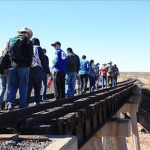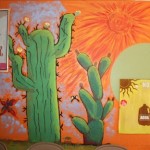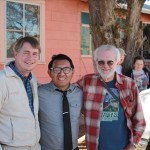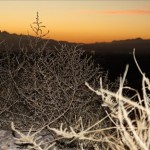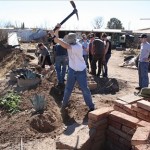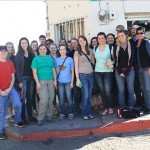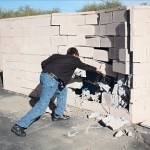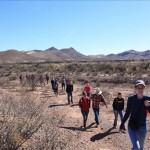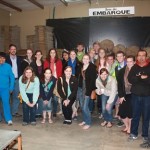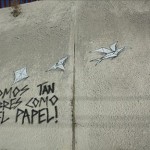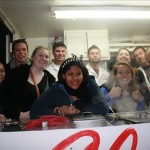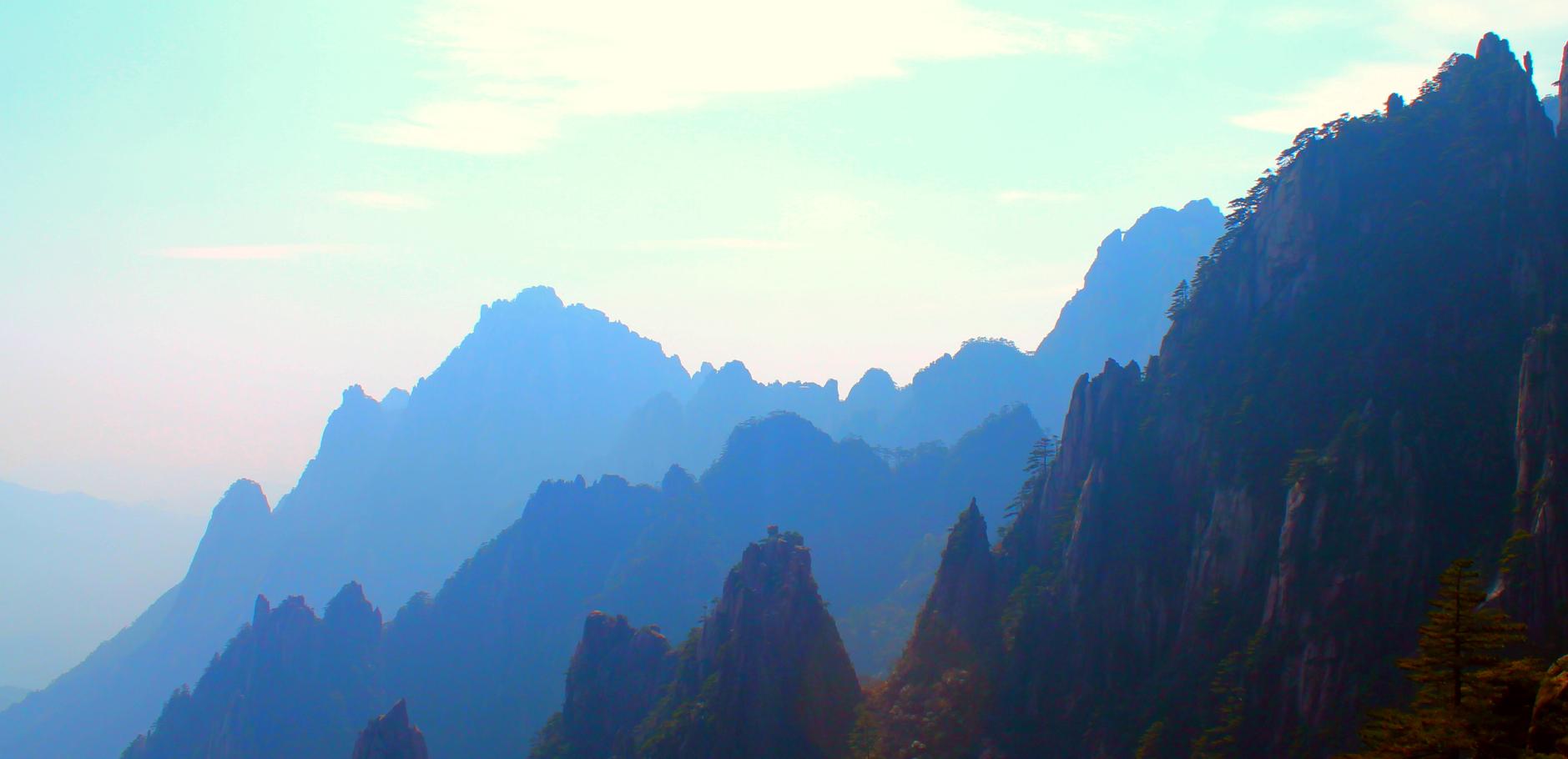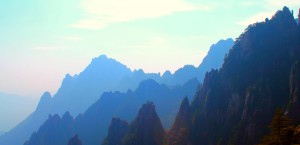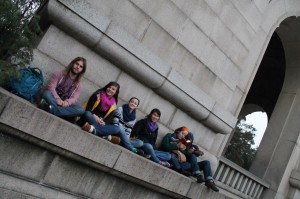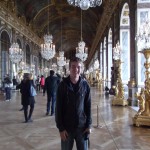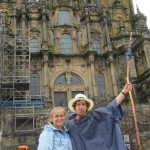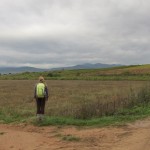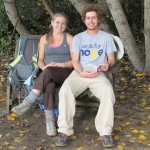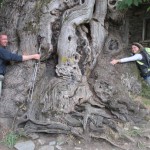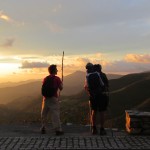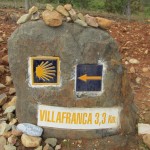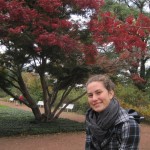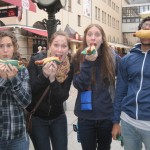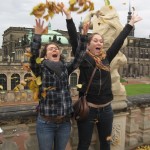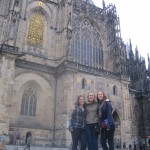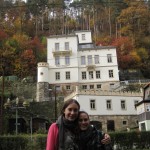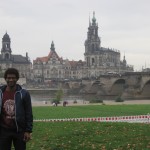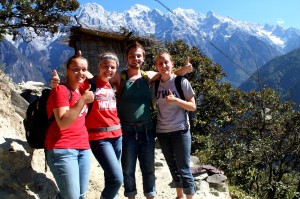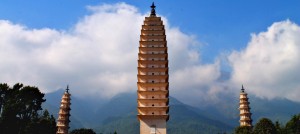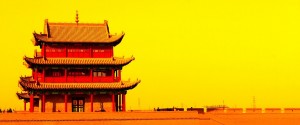Mattie, Mandy, Roberto, Holly
Mandy, Mattie Roberto and I spent our week of independent travel in Germany and the Czech Republic. Although collectively our German and Czech skills were zero, we learned a lot of life skills. For example, nefe in German means yeast (not butter), “classic” water is carbonated and the Czech Koruna is 18 koruna to 1 US dollar. We spent the majority of our time in an apartment we rented in Dresden, Germany where Becca Martin, an EMU student who is studying near Frankfurt, Germany this semester, met up with us to explore the city, and also to take us to Berlin. We also spent one night at the end of our trip in Prague. Highlights of the trip include colorful leaves at the peak of fall in Germany, (there was little of that in Spain) the picturesque beauty of Dresden, a museum on the history of the Nazis’ rise to power and secret police force (right beside the Berlin wall) a semi-spontaneous trip to Saxony Switzerland National Park, an excellent free tour of Prague that was based on tips, and seeing the turn of the hour on the clock in old town Prague. We had a great time eating German and Czech cuisine while trying to take in the reality of very intense stories of the past that took place where we walked. All in all it was a very rewarding trip, and a nice change of pace before heading to Morocco.
-Holly Jensen
Lucas and Matt
Our trip started out with overnight flying to Beaouvois, followed by a morning bus ride to Paris. Upon arriving in a rainy Paris, we looked for food and a place to stay then spent some time walking around and resting. The next two days involved a lot of walking around the city to see landmarks such as the Louvre, Notre Dame, Sacre Coeur, a lit up Eiffel Tower at night and a short trip to Versailles to see the famous Chateau. Friday night we boarded an overnight bus (not our greatest idea in retrospect) and arrived in Strasbourg at 4:30 a.m., walked to the train station, and waited for the next train to Soultz Sous Foret, a small village situated in northeast France close to the German border. We were welcomed by a Mennonite family that Lucas’ mom had lived with 30 years ago. The weekend consisted of some hiking, rock climbing, castle ruins, great food, hospitality, rest and relaxation, learning some French and even a Sunday service at the local Mennonite church. This was by far our favorite part of a very eventful trip. On Monday morning we took a bus to Munich, where we would spend the next few days. While in Munich, we were able to see some beautiful buildings, the site of Octoberfest being taken down, the wonderfully preserved park from the 1980(?) summer Olympics, and even the picturesque Austrian city of Salzburg, the birthplace of Mozart. After a lot of time spent flying, waiting and on buses throughout Thursday, we arrived back in Granada, ready for a short break before leaving for another new country.
-Matt Nyce
Kara and Phil
Yo soy un Pelegrino. We, Kara and I, walked over 220 kilometers (about 150 miles) in eight days on the Camino de Santiago from Ponferrada to Santiago de Compostela in the Spanish province of Galicia. So why be a pilgrim and walk the Camino de Santiago? To think, ask questions, to discover friendship, to experience nature, to feel pain, suffer and keep going, to listen, to share, to laugh and maybe to rekindle faith in humanity. Our pilgrimage was nothing short of incredible–how could I ever put it into words? Our first overnight stay in a pilgrim hostel (called an albergue) we met Fred and Roy, two pretty cool dudes. Fred, retired and still going strong, and Roy our tall friendly Dutchman, journeyed with us and became like family. Sometimes we walked together, sometimes solo, but now we are forever kindred spirits. Fred had a saying he would say each morning–rain or shine– as soon as we stumbled sleepily onto the path, “it’s another fine Camino morning.” Now we’ve been thrown into the next chapter of our adventure (into the wonderful world of Morocco) but I know that the lessons we learned–about ourselves, others and the world around us, will stay with us for the rest of our journey.
-Philip Yoder
Alex, Angelina, Josh, Amanda, James and Sarah
For free travel some of us wanted a more laid back break from studies. It worked out that there were three couples in the group who all had this idea, and we found a cheap beach front apartment in a very nice town called Port de Pollensa, on Mallorca which is a Spanish Island in the Mediterranean.
On the Island we found exactly what we were looking for–a laid back week at the beach. Our typical day consisted of sleeping in, a late breakfast and then going to the beach at about 12 or 1 for a couple of hours. We would normally have lunch at about three or four, which we prepared ourselves, and then relax or go shopping until dinner. We only ate out one time for dinner. We did breakfast and lunch as a couple and then took turns cooking dinner for the group.
Some of the other activities we did included a hike to another nearby beach, (Mallorca has beautiful mountains) renting bikes for a day and a two hour snorkeling trip. We also had movie nights and game nights as a group. Overall Port de Pollensa made for a very fun and relaxing independent travel and although we didn’t leave Spain, we were able to see a very different part of the country from Granada.
-Alex Witmer
Mckenzie, Michelle, Melinda and Becka
Mckenzie, Michelle, Melinda and I spent a week in the sleepy town of Reggio Emilia, Italy for independent travel. We spent one night in Malaga prior to leaving Spain which consisted of a makeshift lunch of chocolate, nuts, crackers and sliced cheese (because we were too cheap and hungry to go buy lunch), downtime by the pool with a beautiful view of the beach, and colorful conversation with an Irish man we befriended during our stay. After a taxi, plane, bus and train (every form of transportation except a boat) we arrived in Reggio around ten, starving and ready for some motherly love from Michelle’s aunt Sharon who we were staying with!
Some highlights of our trip include an exclusive tour of the pamagiano reggiano cheese factory (with free samples) a gondola ride in Venice, quality time with Sharon’s crazy cat, Maurice, and FOOD! We had the most amazing pasta including ravioli filled with squash which was specific to Reggio and we learned how to make gnocchi. But that’s not all, the pizza and gelato were out of this world! Best food ever! Also while in a town called Parma, we ran into a couple from Baltimore who saw my EMU shirt and immediately thought Harrisonburg! Such a small world. Overall, it was a relaxing week spent with some great friends, and I have many memories that will last a lifetime.
-Becka Richman
Annika and Taylor
Our independent travel was all about relaxation so we headed to a small town in Portugal called Albufeira which is located along the Atlantic Ocean. We rented a small studio apartment just big enough to be comfortable. The first three days were warm and sunny, so we gladly lounged around the pool to soak in the sun. We also wandered around our little town finding groceries, touristy shops and restaurants.
The beach was just a five minute walk away from our place, so while it was a bit too chilly to go swimming, we enjoyed the sand and shells. A highlight of our time in Portugal was our day trip to Lagos. We explored the city finding the location of an old slave market, a fortress and a museum of Lagos history. We returned to Granada and the rest of the group rejuvenated and ready for the next chapter of our cross-cultural in Morocco.
-Annika Maust
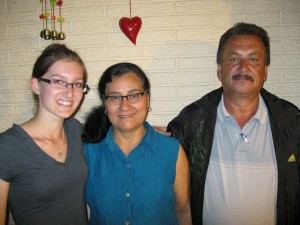
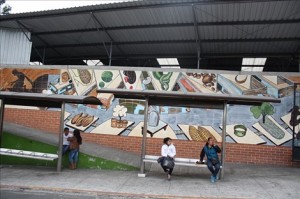 After lunch, from 1:30 to 4:30, we do something as a group. Yesterday we went to the Central Plaza and the market (both are gorgeous) and today we are having a siesta and time of rest. We have already discovered a shopping center within walking distance of the school and after lunch several of us like to walk there and purchase pastries at Isopan (a wonderful bakery) and explore the city. Around 4:30 we return to our host families and it is there that we do our homework, talk with our host families, sometimes pretend to understand them, but overall enjoy experiencing Guatemalan culture and life with them. The two of us are extremely grateful that our families typically eat dinner around 7 instead of 9 or 10 like some families.
After lunch, from 1:30 to 4:30, we do something as a group. Yesterday we went to the Central Plaza and the market (both are gorgeous) and today we are having a siesta and time of rest. We have already discovered a shopping center within walking distance of the school and after lunch several of us like to walk there and purchase pastries at Isopan (a wonderful bakery) and explore the city. Around 4:30 we return to our host families and it is there that we do our homework, talk with our host families, sometimes pretend to understand them, but overall enjoy experiencing Guatemalan culture and life with them. The two of us are extremely grateful that our families typically eat dinner around 7 instead of 9 or 10 like some families.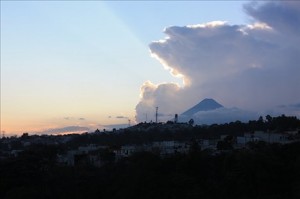 birds, plantains, the view that we have at CASAS of the mountains and the volcanos, the bright colors, and the willingness of people to open their hearts and homes to newcomers such as ourselves.
birds, plantains, the view that we have at CASAS of the mountains and the volcanos, the bright colors, and the willingness of people to open their hearts and homes to newcomers such as ourselves. people living in Guatemala, our host families, and each other as a group.
people living in Guatemala, our host families, and each other as a group.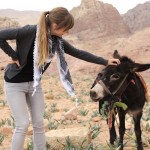
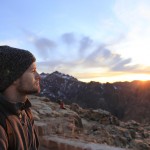
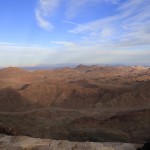
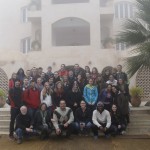

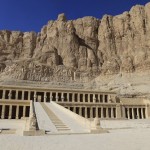
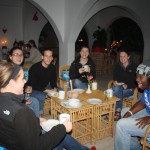
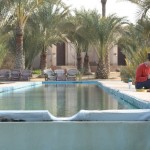
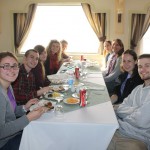
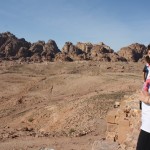

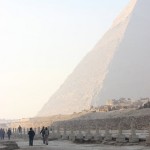

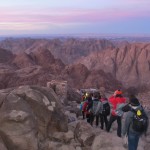
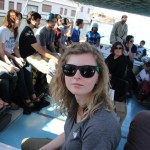

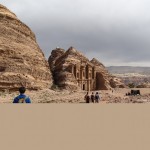
 On our first morning in Giza, only a few hours after our 30 hours of travel to Egypt ended, our bus shoved its way through the dusty streets. Everyone with a window seat stifled gasps, fearing first that we would ram into truck full of oranges, then that we would kill the family of goats led by a young Egyptian, or any number of other possibilities leading to a traffic jam across seven unofficial lanes of vehicles. Our panic quieted only after three huge triangles loomed out of the dusty, fogged sky. Our first morning in Egypt, and we had already encountered the Great Pyramids! Many mornings and amazing sights have followed, like the Sphinx in Giza, King Tut’s golden mask in Cairo, the Nile in Luxor, the gorgeous sandstone walls of the Siq in Petra, and the salt crystals edging the green-blue waters of the Dead Sea.
On our first morning in Giza, only a few hours after our 30 hours of travel to Egypt ended, our bus shoved its way through the dusty streets. Everyone with a window seat stifled gasps, fearing first that we would ram into truck full of oranges, then that we would kill the family of goats led by a young Egyptian, or any number of other possibilities leading to a traffic jam across seven unofficial lanes of vehicles. Our panic quieted only after three huge triangles loomed out of the dusty, fogged sky. Our first morning in Egypt, and we had already encountered the Great Pyramids! Many mornings and amazing sights have followed, like the Sphinx in Giza, King Tut’s golden mask in Cairo, the Nile in Luxor, the gorgeous sandstone walls of the Siq in Petra, and the salt crystals edging the green-blue waters of the Dead Sea.